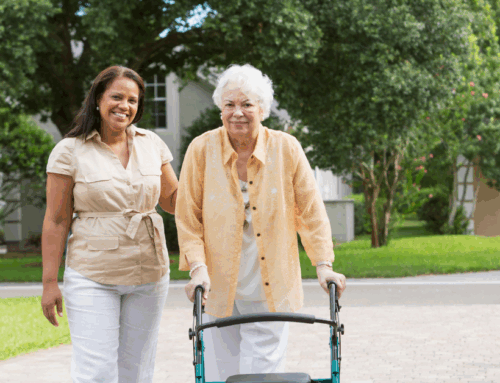Elder abuse is defined multiple ways. The U.S. Administration on Aging labels elder abuse as ‘any knowing, intentional, or negligent act by a caregiver or any other person that causes harm or a serious risk of harm to a vulnerable adult.’ Unfortunately, this is something that happens every day. The possibility of elder abuse happening behind closed doors is all too real. Even worse, it happens with both family members and “professional” caretakers. This is why recognizing the signs and knowing what to do is so important. It enables the families and friends of seniors to better protect them from potential harm. Here are some ways you can recognize if your elderly loved one might be suffering abuse at home in your absence.
Different Types of Elder Abuse and the Signs to Look For
The warning signs of elder abuse are many and varied depending on the type of abuse. There are many different forms, but the most common seem to be exploitive, emotional, physical and neglectful abuse.
Exploitative Abuse
Exploitative abuse is one of the most difficult forms of elder abuse to track. Unfortunately, it’s also the most common. Look at your elderly loved one’s financial accounts. Fishy ATM activity, large or frequent withdrawals, or skyrocketing credit card debt are all evidence of potential exploitative elderly abuse.
Emotional Abuse
Seniors who experience emotional abuse from their caretaker are probably not going to be forthcoming about it. In fact, emotionally abused seniors have a tendency to “shut down.” This includes unresponsiveness to posed questions, fears or concerns. If your senior loved one seems to “shut down” a lot, it’s possible that the caretaker is emotionally abusive. Additionally, seniors subjected to emotional abuse may be unwilling to go out, see friends or family and might even exhibit sudden changes in behavior.
Physical Abuse
Physical abusers can cover their tracks by brushing off injuries as accidental injuries. Look for unusual bruises. Make note of any bruising you find on the arms, shoulders or neck. Furthermore, ask about unexplained or suspicious injuries. If your loved one refuses to receive medical attention for injuries and the caregiver dismisses your concerns, you might be dealing with a case of physical elder abuse.
Neglectful Abuse
Neglect, unlike other forms of elder abuse, is thankfully pretty easy to identify. Poor personal hygiene, unhealthy eating habits and an irregular medication schedule are all signs of caretaker neglect. Other red flags include dirty clothes, rapid weight loss, pressure sores (also called bed sores)and any signs of sleeping problems or insomnia.
The Risk Factors and Prevention Methods of Elder Abuse
Sometimes the warning signs of elder abuse can be hard to read. Even when you see the signs— like bruises, for example— you might just think they were one-off accidents. So, knowing the risks can help you act accordingly to prevent any abuse from starting in the first place. The more common risk factors for both the senior and the caretaker can be found below.
A senior at risk is isolated even with at-home assistance.
Elderly abuse is statistically more likely for seniors who live in isolation. This is especially true if seniors who live at home have no access to the outside world without the assistance of their caregivers. Alternatively, seniors in constant contact with their families and friends are much less likely to be abused. Be sure that your senior loved one is getting interaction without others outside of the caretaker.
A senior at risk has declining physical or cognitive health.
The risks of elder abuse increase among seniors who are chronically ill and/or have deteriorative cognitive conditions like Alzheimer’s or dementia. In either case, ill-intentioned caregivers can easily take advantage. Make sure that your senior loved one is being cared for properly by checking in and staying involved with the caretaker’s routine.
The caregiver in question is dependent on the senior.
The risks of elder abuse increase when the caregiver and senior live together, or when the caregiver is at least partly financially dependent on the senior. This is more often the case when the caregiver is from within the family and not from a senior care service agency. By staying involved and being on the lookout for any unusual behavior, you’ll have a better chance of intervening if it turns out your loved one’s caretaker has selfish intentions.
Acting Accordingly in the Event of Elder Abuse
Don’t hesitate to call the police if your suspicions turn out to be true. Firing the caretaker isn’t enough— he or she might go on to do this to other vulnerable seniors. Taking matters into your own hands isn’t a good idea, either. Doing this might accelerate the situation, potentially putting you and your senior loved one at risk if the caretaker turns out to be dangerous. Notifying the proper authorities is the best thing you and others can do. Helping put abusers in jail not only protects vulnerable seniors but also opens up opportunities for the caretakers who are actually honest, kind and good at their jobs.
Prevent Elder Abuse with a Referral from Florida First
Placing your trust in someone who only ended up hurting your family is one of the worst experiences a person can have. After all, the caregiver you select for your elderly loved one is expected to provide the best care possible. But there is hope: for every one elder abuser, there are thousands of real caretakers who truly care. These are the ones you can find through the referral services at CareGivers of America. If you are in need of a new, thoroughly-screened caretaker for your senior loved one, give us a call at 561-771-5980.





